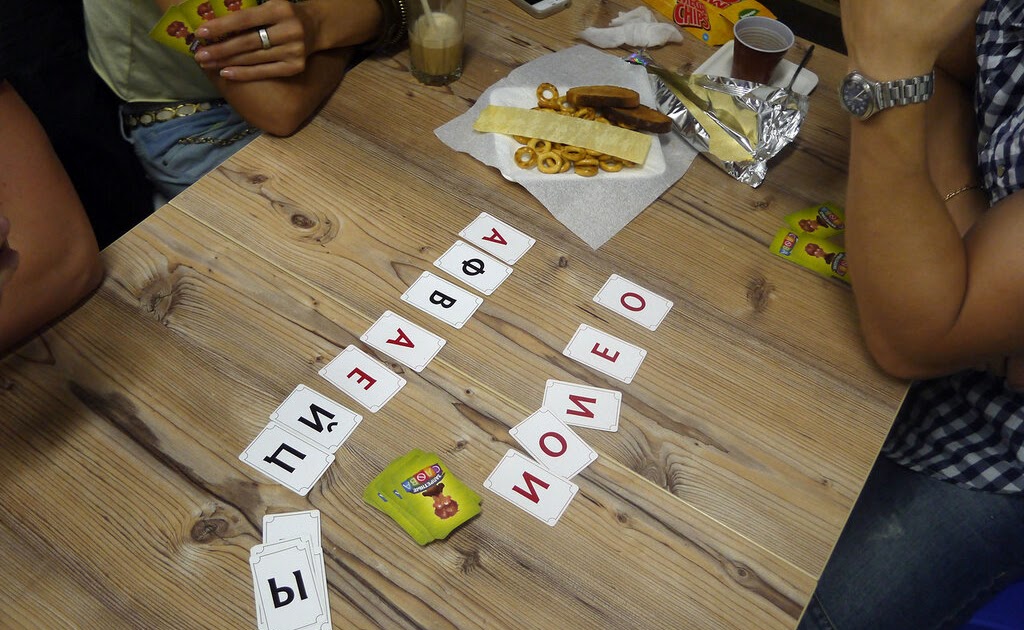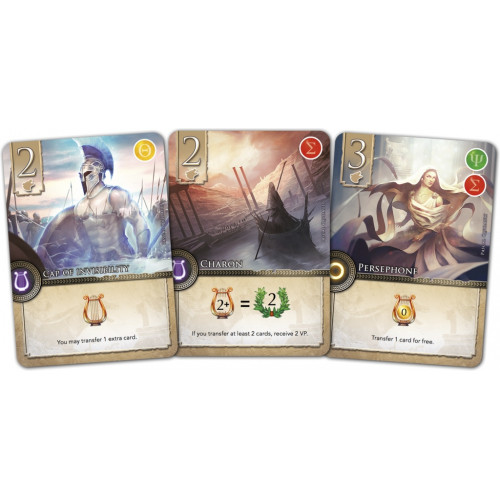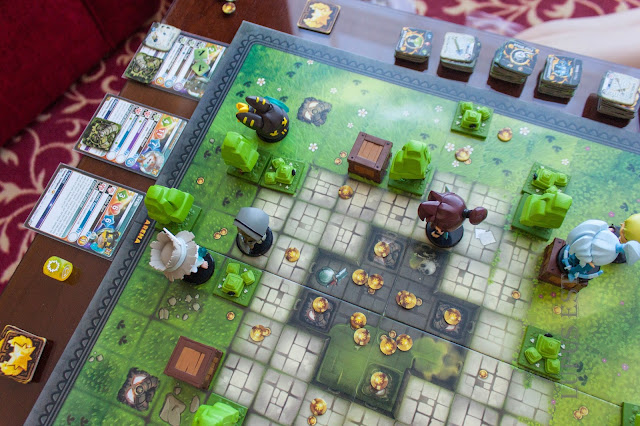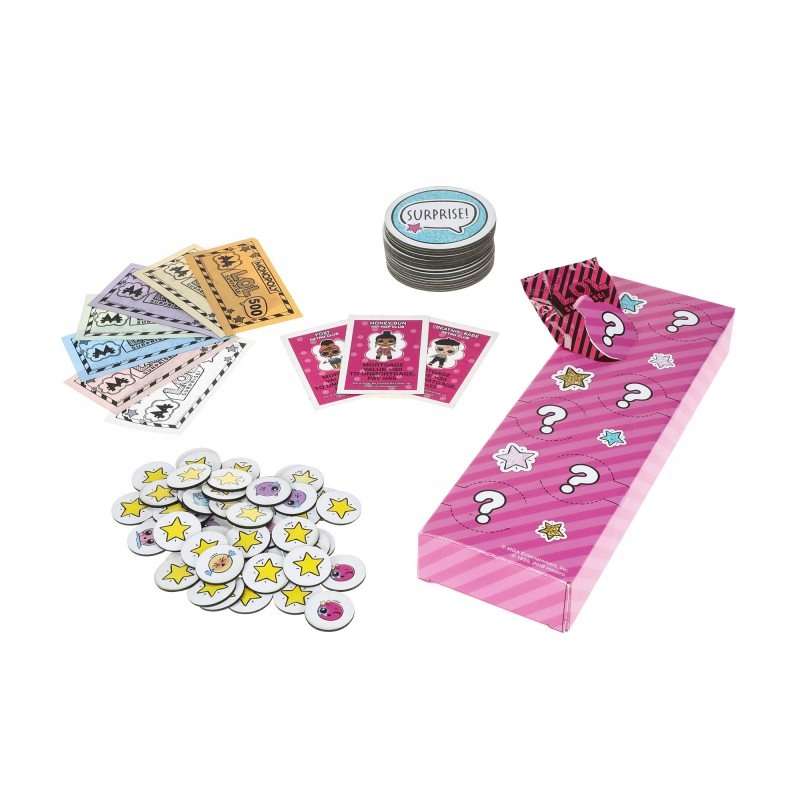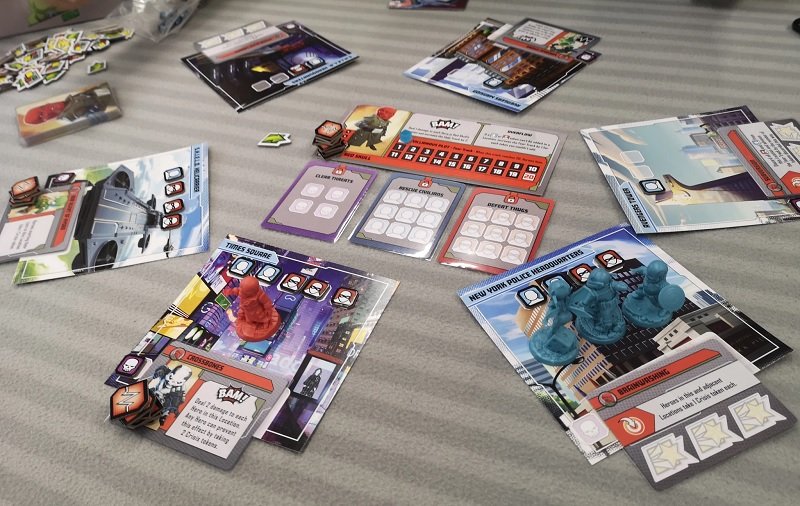I. The players place their people on the game board
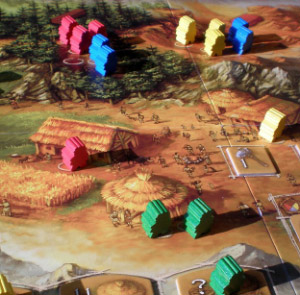
The start player begins and must place 1 or more of his people on one place of his choice.
Then the next player in clockwise order follows and must also place 1 or more of his people on one place of his choice. This continues in clockwise order until all players have placed all their people on the game board.
The number of rings in a place indicates how many people can be there before it is full.
Passing is not permitted, if there are still places available for people. Placing again is not permitted.
How many people can be placed at the individual places?
- Tool maker – 1
- Hut – 2
- Field – 1
- Hunt – unlimited
- Resource spaces – up to 7 people
- Buildings – 1
- Civilization cards – 1
Since the individual places accept different numbers of people figures, it often occurs that one or more players will have no more people figures to place while others still have people figures they can place.
If no player can place people figures (because each has already placed all his figures or each has no legal places to place the figures he has), the 2nd phase begins.
End of the Game
The game ends in one of two ways:
If there are not enough civilization cards remaining to fill the display at the beginning of the round, the game ends immediately. In this case, no new round is begun.
If at least 1 building stack is empty. In this case the current round is played to the end, i.e. the people must still be fed.
Then follows the final scoring. First, take the information sheet for the civilization cards for the scoring information it has. Each player proceeds as follows:
Multiple the different civilization cards with the green backgrounds by themselves.
Score the cards with sand-colored backgrounds as follows:
- Multiple the number of farmers by the position of the player’s marker on the food track.
- Multiply the number of tool makers by the value of the player’s tools.
- Multiply the number of hut builders by the number of buildings.
- Multiply the number of shamen by the number of people.
- Each resource that a player has on his player board scores 1 point
Players move their scoring markers to score their points as they tabulate them. The player with the most points is the winner!
If players are tied for most, the player among them with highest total of food production, tools, and people is the winner.
Continue Reading
Setup
Place the game board in the table middle.
Separate the food tiles by value and place in stacks on the hunting grounds.
Place the 20 wood resources in the forest, 16 brick resources in the clay pit, 12 stone resources in the quarry and 10 gold resources in the river.
Separate the tools by values 1/2 and 3/4 and place them in two stacks in the space next to the tool maker.
Shuffle the civilization cards and place as a face down stack next to the game board. Draw the top-most 4 cards (based on number of players) and place on the 4 spaces, from right to left.
Shuffle the building tiles and place in 4 face down stacks of 7 buildings each. With 4 players, place all 4 stacks on the game board; with 3 players, place 3 stacks; and with 2 players, place 2 stacks. Return unused stacks to the box. Turn over the top-most building tile on each stack.
Each player chooses a color and one marker of his color on space 0 of the food track (lower left) and one on the scoring track (upper left).
Each player takes 1 player board. On this, he places 5 people in his color and 12 food. The player boards serve as places for game material, game play information, and final scoring information.
Place the remaining people (5 per color) as a general supply next to the game board. Also place there the 7 dice and the dice cup.
Choose a start player and begin the game.
II. The players use the actions of their placed people
The start player begins. He uses all his placed people figures. Only then does the next player, in clockwise order, use his people. The order a player chooses to use his people is completely up to him.
The player returns people use to his player board as he uses them. In this way, the player has all his people back when he is done.
Which actions can the player use on the individual places?
Tool Maker
Here the player takes 1 new tool. If he has no tools, then he takes a value 1 tool and places it with the number 1 showing on one of the spaces for tool on his player board.
Each tool tools can be used only once per round to roll a die with the hunt or during resource procurement. A tool can be only completely used. Thus, it can split and used later for a different action.
A player can add as many of his tools to a dice roll. In order to show that a tool was used, the player turns it around by 90°.
Here the player takes 1 additional people figure of his color from the general supply. He has thereby for all following rounds one more people figure available.
The player returns his people figure to his player board and moves his marker on the food track 1 space upward. Thus, he increases his food production, which he receives at the end of each round.
Hunt
The player takes 1 die for each of his people figures on the hunt and rolls them all together. He adds all the pips on the dice.
Then he can add as many of his tools to the total from the roll. For each full 2 of the thrown total, he takes 1 food from the game board.
Forest, Clay Pit, Quarry, and River
At these 4 places, the players take wood, brick, stone, and gold.
The procurement of these resources works in the same way as the hunt, except that the yields are different:
- Forest – for each full 3, the player takes 1 wood from the supply.
- Clay pit – for each full 4, the player takes 1 brick from the supply.
- Quarry – for each full 5, the player takes 1 stone from the supply.
- River – for each full 6, the player takes 1 gold from the supply.
Civilization Cards
The player pays the number of resurces shown above the card to the supply from his player board and takes the card
Which resources the player pays (from wood, brick, stone, and/or gold) is up to him and what he has: usually it will be wood and/or brick, but he can never use food.
If the player cannot or does not want to pay the required resources, he takes back his people figure and leaves the card on the game board.
Each player stacks his acquired civilization cards face down on the designated space on his player board.
Buildings
The player pays the resources shown on the building to the supply from his player board and takes the building.
Then the player immediately moves his scoring marker on the scoring track by the number of spaces shown on the building. Afterwards, he turns over the next building on this stack.
There are 8 buildings where the player can choose which resources to pay with, but the number is fixed. And there are 3 buildings, where the player can choose both the kind and number of resources to pay with (maximum 7).
When a player takes one of these buildings, he must calculate the number of spaces (= points) he moves on the scoring track.
The player places the acquired building on one of the spaces for buildings on his player board. If a player acquires more than 5 buildings, he stacks them on these spaces.
Кто захочет купить настольную игру 100000 лет до нашей эры
Главным образом эта настольная игра понравится новичкам, благодаря своей внешней привлекательности, но и опытным игрокам игра тоже придется по вкусу, так как в ней есть несколько нюансов и хитростей, которые можно освоить не сразу.
100000 лет до нашей эры — это очень красиво оформленная настольная стратегия в которую так и хочется играть всей семьей, при этом она достаточно сложна и интересна, чтобы увлечь даже бывалых настольных игроков.
В целом Каменный Век это очень хорошая семейная настолка и мы советуем поиграть в нее каждому, кто увлекается настольными играми, тем более она теперь доступна на русском языке.
III. the Players Feed Their People
When all players have taken all their people figures back to their player board, they must feed their people. Each people figure requires 1 food.
First, each player takes food from the supply according to the postion of his marker on the food track. Then each player returns 1 food to the supply for each people figure on his player board.
If a player does not have sufficient food to feed his people, then: He must place all food that he has back into the supply.
Then, he may, if he wants to (and can), pay the remainder in the form of any resources into the supply. Each resource replaces 1 food. Thus, his people are also content as they were able exchange the resources for food).
If the player cannot or does not want to do this, he immediately moves his scoring marker backwards 10 points on the scoring track.
In such case, the player must return all food he has to the supply. When all players have fed their people (or not and lost 10 points), the round ends. The start player gives the start player marker to his left neighbor and the next round begins.
Правила настольной игры 100000 лет до нашей эры
Подготовка и компоненты
Игра упакована в нестандартную высокую коробку, которая оправдана большим количеством компонентов. Авторы не пожалели вложить даже кожаный стаканчик для более удобного кидания кубиков.
Игровое поле представляет собой большую первобытную деревню. На него выкладываются фишки всех типов добываемых ресурсов и инструменты. Каждый игрок получает специальную карточку, на которую помещает 5 фигурок людей и 12 пищи. Оставшиеся человечки отправляются в запас рядом с игровым полем, а фишки игроков помещаются на треки Питания и Победных очков.
Карточки Цивилизаций перемешиваются и располагаются в стопке рядом с полем, а верхние четыре помещаются на специальные деления на поле.
Перемешанные фишки жилищ формируют равные стопки, которых размещается на поле столько, сколько игроков в партии. Самый младший из них по правилам настольной игры 100000 лет до нашей эры становится первым и игра начинается.
Начало игры
Каждый раунд в игре состоит из трех фаз.
В начале игроки по очереди отправляют соплеменников на игровое поле. Можно отправится на пашню, которая будет постоянно приносить пищу, в мастерскую, чтобы изготовить орудия труда или поместить двух человечков в хижину, чтобы получить пополнение.
Добыча ресурсов и охотничьи угодья
На добычу любого ресурса в настольной игре Каменный Век можно отправить сразу несколько человек, но при этом они займут такое же число клеток. Естественно, отправиться на уже занятые места нельзя. Единственным исключением служат охотничьи угодья, туда может отправить сколько угодно людей любой участник.
Строительство жилища
Игрок может отправить человека за карточкой цивилизации или на строительство жилища.
Когда все фишки размещены, участники строго по одному получают плоды работы, забирая при этом трудящихся.
Получение ресурсов
В деревне все просто, за чем пришли, то и получили, а вот над добычей ресурсов придется потрудиться. Игрок кидает столько кубиков, сколько рабочих отправил на сбор данного ресурса, затем выпавшие на кубике значения складываются и делятся на число, указанное в таблице на карточке игрока. Именно столько данных ресурсов и получает игрок.
Инструменты
Для облегчения добычи ресурсов служат инструменты. По правилам настольной игры 100000 лет до нашей эры, игрок может повернуть любой из своих инструментов, чтобы добавить число на нем к результату броска. Инструменты добавляются на карточку участника последовательно. Сначала игрок должен получить три инструмента первого уровня, а при каждом следующем посещении мастерской их эффективность будет постепенно расти, до двух, до трех и даже до четырех.
Карточки Цивилизаций
Карточки Цивилизаций и Жилища приносят игроку победные очки, но чтобы ими завладеть придется расстаться с ресурсами. Карты Цивилизаций приобретаются за такое количество любых ресурсов, которое указано над ними. А вот для строительства жилища необходима определенная комбинация ресурсов, при чем она может быть как строгой (когда ресурсы обозначены на самой карточке), так и свободной, когда игрок сам решает из чего ему строить. Выполнить такие условия как правило сложнее, но за них можно получить гораздо больше победных очков.
Фаза кормления
Когда игрок завершил все свои действия и забрал своих людей, ход переходит к следующему, а когда все готовы начинается фаза кормления.
Каждый человечек в настольной игре Каменный Век потребляет единицу пищи. Если еды не хватает, на нее можно обменять ресурсы, но тут уже выбирать не приходится: и дерево и золото обменяется на единицы еды один к одному. А вот если и после этого прокормится не удалось игрок теряет 10 победных очков.
Конец игры
Когда с едой покончено самое время обновить специальные деления. Оставшиеся карты Цивилизаций сдвигаются максимально вправо, а затем из колоды добираются новые. Если добирать нечего, то игра завершена. Так же игра завершится, если выяснится, что одна из стопок жилищ пуста.
К полученным каждым игроком очкам добавляются очки за кары цивилизаций. Количество разных изобретений возводится в квадрат, а карты с песочным фоном приносят очки в зависимости от развития игроком той или иной отрасли.
- 100000 лет до нашей эры
- Экономические игры


